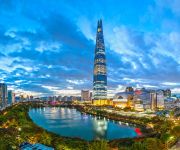Facts and Data
Webpages:
Official Unesco Page
Basis Data:
Unesco World heritage since: 2014
Size of heritage: 409 ha
- Buffer zone: 854 ha
Coordinates:
Longitude: 127,181°
Latitude: 37,479°
Summary
Namhansanseong was designed as an emergency capital for the Joson dynasty (1392–1910), in a mountainous site 25 km south-east of Seoul. Built and defended by Buddhist monk-soldiers, it could accommodate 4,000 people and fulfilled important administrative and military functions. Its earliest remains date from the 7th century, but it was rebuilt several times, notably in the early 17th century in anticipation of an attack from the Sino-Manchu Qing dynasty. The city embodies a synthesis of the defensive military engineering concepts of the period, based on Chinese and Japanese influences, and changes in the art of fortification following the introduction from the West of weapons using gunpowder. A city that has always been inhabited, and which was the provincial capital over a long period, it contains evidence of a variety of military, civil and religious buildings and has become a symbol of Korean sovereignty.
Location on Map
Show bigger map on Openstreetmap
Namhansanseong: A UNESCO World Heritage Site in South Korea
Namhansanseong, located at coordinates N37 28 44 E127 10 52, is a remarkable UNESCO World Heritage site in South Korea. This ancient fortress, situated on Namhansan Mountain, holds great historical and cultural significance for the country. With a rich history dating back to the 7th century, Namhansanseong has witnessed numerous battles, invasions, and political changes throughout the centuries.
History
The construction of Namhansanseong began during the Silla Dynasty in 672 AD, as a strategic military fortress to protect the capital city of Silla, which is now known as Seoul. Over the years, the fortress underwent several expansions and renovations under different dynasties, including Goryeo and Joseon. It served as a crucial defense system against foreign invasions, particularly from the Mongols and Japanese.
During the Imjin War in the late 16th century, Namhansanseong played a pivotal role in defending the capital against Japanese forces. The fortress successfully withstood multiple attacks, becoming a symbol of resilience and national pride. However, it was eventually abandoned in the 17th century as the capital moved to Seoul.
Current State
Today, Namhansanseong stands as a testament to Korea's architectural and military prowess. The fortress covers an area of approximately 4.7 square kilometers and is surrounded by a 12-kilometer-long stone wall. The wall, built with granite stones, showcases the exceptional craftsmanship of the time.
Visitors to Namhansanseong can explore various historical structures within the fortress. One of the most notable is the South Gate, known as Janggyeongmun. This gate served as the main entrance to the fortress and features intricate carvings and beautiful wooden doors. Another prominent structure is the Hyeonjeolsa Shrine, which was built to honor the soldiers who sacrificed their lives defending the fortress.
The natural surroundings of Namhansanseong are equally captivating. The fortress is nestled amidst lush forests and offers breathtaking panoramic views of the surrounding landscape. Visitors can hike along the well-maintained trails, immersing themselves in the serene beauty of the mountain.
Efforts have been made to preserve and restore Namhansanseong to its former glory. The site was designated as a UNESCO World Heritage site in 2014, recognizing its historical and cultural significance. Ongoing conservation projects ensure that the fortress remains accessible to future generations, allowing them to appreciate its architectural brilliance and historical importance.
Conclusion
Namhansanseong stands as a living testament to Korea's rich history and cultural heritage. Its strategic location, architectural marvels, and historical significance make it a must-visit destination for history enthusiasts and nature lovers alike. As a UNESCO World Heritage site, Namhansanseong continues to captivate visitors with its timeless beauty and serves as a reminder of Korea's enduring spirit.
Hotels and places to stay
SIGNIEL SEOUL
Lotte Hotel World
Vista Walkerhill Seoul
Militopia Hotel
Courtyard Seoul Pangyo
HOTEL PARK HABIO
Hotel Infini
HOTEL DELIGHT
Videos from the area
Videos provided by Youtube are under the copyright of their owners.















